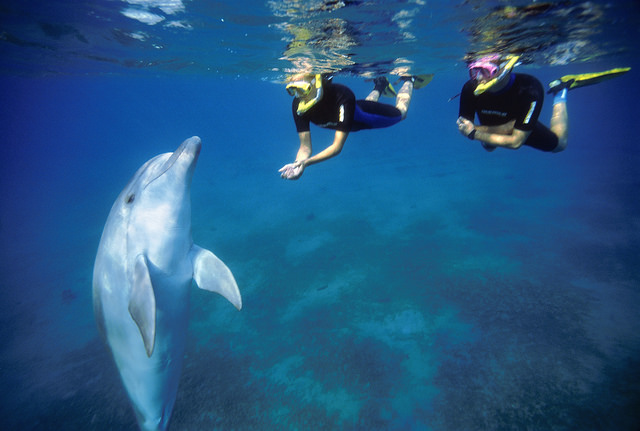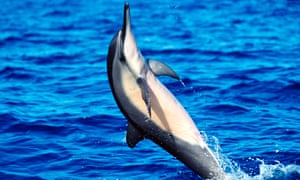http://e-info.org.tw/node/118016
與海豚「共游」成變相騷擾 夏威夷擬修法禁止
文字大小
100 1 Share1
本報2016年8月30日綜合外電報導,姜唯編譯;蔡麗伶審校
近幾年很夯的「與海豚共游」體驗,卻可能暗藏生態殺手。專家提醒,海豚睡覺時也在游泳,而人們往往沒有察覺已吵醒牠們了。美國聯邦政府如今打算禁止遊客在夏威夷與海豚共游。這可能粉碎許多人的美夢,但海豚卻總算能有個好夢。
與海豚共游是打擾。攝影:Tony Malkevist。圖片來源:Israeli Ministry of Tourism(CC BY-ND 2.0)。
睡眠中...勿擾! 白天是海豚休息時間
新禁令將明文規定,接近飛旋海豚50碼(約50公尺)以內就算騷擾。而騷擾飛旋海豚或是任何海洋哺乳動物,都已違反海洋哺乳動物保護法。
近來海豚觀光越來越熱門,許多遊客包車造訪海豚常出沒的海灣。美國國家海洋漁業局保護規劃和規則制定部長普茲(Susan Pultz)指出,飛旋海豚是夜行性動物,夜間在深海覓食,白天回到淺海休息。
「(與海豚共游)的遊客其實是在打擾牠們睡覺。我們都知道,幾天不休息就會影響健康。」普茲說。
潛客組團圍堵自拍 海豚不得安眠
由於飛旋海豚作息固定,旅遊業者知道何時可在哪裡遇到休息的海豚。「有時會有多達13艘遊船、60個浮潛遊客在水中互相卡位,要佔到好位置。此外,有些地區還流行與海豚交流的靜修冥想活動、海豚療法和其他海豚相關的心靈儀式。」
普茲說,漁業局的確觀察到與人互動增加後,海豚行為有所變化,包括躲避人類、在空中的行為變多、太多船隻出現時會離開海灣,這些活動都會增加牠們的能量消耗。
「我們常常看到船從一群海豚之間駛過,導致海豚母親與孩子分開,這完全不可取。」
在當地做生意23年的洛薩諾表示,由於自拍風氣盛行,人們對海豚的行為已經相當失控,包括拿著自拍棒追海豚,「你去非洲獵遊就不會想去追獅子、摸獅子。」
美政府擬訂定安全距離 旅遊業者也認同
歐胡島海豚遊覽業者洛薩諾(Victor Lozano)對新管制措施表示歡迎:「早該這麼做,我們已經準備好。」洛薩諾強調,他希望新措施能限制遊船和泳客。
目前夏威夷、阿拉斯加規定遊客必須與座頭鯨保持100碼以上的距離,普吉特海灣遊客也必須與虎鯨保持同樣100碼以上距離。新禁令是首次針對飛旋海豚制定規範。
這個法案現進入60天公眾評論期。普茲表示,大概要花一年時間才會正式通過。
【延伸閱讀】
【相關文章】
【參考資料】
Swimming with dolphins could end as 'self-gratifying selfies' pose threat
In Hawaii, large numbers of visitors disturb nocturnal spinner dolphins, which continue moving while they snooze
The federal government is proposing a ban on swimming with dolphins in Hawaii– a move that may crush the dreams of many tourists, but will allow the marine mammals to finally get a good day’s sleep.
The proposed rule would bar people from swimming or approaching within 50 yards of the Hawaiian spinner dolphin. The dolphins are an increasingly popular attraction for tourists, who pay for chartered tours of the bays the dolphins frequent.
Spinner dolphins are nocturnal, foraging in the deep ocean at night and returning to shallow waters to rest during the day, said Susan Pultz, the chief of conservation planning and rule-making for the National Marine Fisheries Service.
“When you get the numbers [of tourists] we’re seeing, they’re constantly disturbed all day long. That’s their resting period,” said Pultz.
“As we all know, if you don’t rest day after day after day, it does affect your fitness.”
Spinner dolphins continue swimming while they are sleeping, so people may not be aware they are waking the cetaceans up.
The predictable habits of spinner dolphins have been taken advantage of by commercial tour operators, who know exactly where and when to find the resting creatures.
“At some locations, up to 13 tour boats have been observed jockeying for position on a single dolphin group, with up to 60 snorkelers in the water,” the rule reads. “In addition, organized retreats centered on dolphin encounters, dolphin-assisted therapy, and dolphin-associated spiritual practices have flourished in certain areas.”
Pultz said her agency has observed changes in dolphin behavior due to the increase in human interaction, including dolphins avoiding people, increasing their aerial behavior, and leaving bays when too many boats were present, all of which require them to expend extra energy.
“We see all the time boats going right through the pods, separating the moms and the calves,” she said. “It’s just not a good situation at all.”
Victor Lozano, the owner of Dolphin Excursions in Oahu, said he welcomed the new regulations.
“It’s long overdue. We’re ready for it,” Lozano said, emphasizing that he wanted to see the regulations enforced against boats and swimmers alike.
Lozano has been providing boat tours for 23 years and said that the behavior of people toward the dolphins had gotten out of control, which he blamed on the desire for “self-gratifying selfies”.
“People chase the dolphins with the selfie sticks,” he said. “You go on safari – you don’t go out to the lion and try to pet it.”
Harassing spinner dolphins – or any marine mammal – is already illegal under the Marine Mammal Protection Act. The proposed rules would clarify that getting within 50 yards of a spinner dolphin is considered illegal harassment.
The government has previously passed specific regulations barring people from approaching within 100 yards of humpback whales in Hawaii and Alaska and killer whales in the Puget Sound. This would be the first rule addressing swimming with spinner dolphins.
The proposed rule now enters a 60-day public comment period, and Pultz said it would probably not be finalized for a year.
Katie Paki, who works on a boat offering dolphin and whale-watching tours on Maui, said her company did not allow its customers to swim with dolphins anyway.
“They get to see them and take pictures form the boat,” she said. “It’s a dolphin experience. You’re just not swimming with them.”



沒有留言:
張貼留言